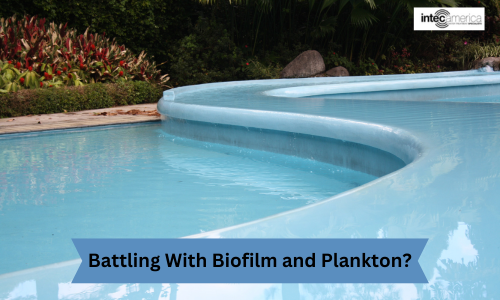Efficacy of Copper-Silver Ionization in Controlling Biofilm- and Plankton-Associated Waterborne Pathogens

What is Copper-Silver Ionization and How Does it Work?
This treatment method works through electrolysis. The system produces positively charged copper and silver ions. Because bacterial cell walls have a negative charge, these ions are attracted to the cell walls, causing the proteins to break down, eliminating the walls and destroying the bacteria.
That means that Copper-Silver ionization as a disinfecting tool is an incredibly important part of dealing with water-borne diseases and bacteria.
What is the Difference between Biofilm and Planktonic Forming Bacteria?
So, what are those types of bacteria?
What Is Biofilm Forming Bacteria?
Biofilm-forming bacteria are bacteria that are attracted to surfaces, and/or other bacteria so that they form clusters of bacterial cells. When these cells bind together they create a self-produced matrix, which is important because that matrix network of cells is protective of the bacteria inside.
Biofilms help bacteria survive environmental stress, distribute resources, and survive in challenging conditions.
When it comes to bodies of water, like pools, cooling towers, and almost any form of water storage, biofilms can form in stagnant areas and eventually grow till the bacteria infect most or all of the water.
What Is Planktonic Forming Bacteria?
Planktonic bacteria, on the other hand, don’t group together generally and are free-floating throughout a body of water.
This is important because these bacteria behave differently, collect in different environments, and tend to be highly individually adaptable instead of overcoming difficulty through group survival.
Biofilm-Forming Bacteria Vs. Planktonic Forming Bacteria
The trick is that, once a biofilm has formed, biofilm-forming bacteria tend to be more resistant and likely to survive disinfecting attempts.
As individuals, biofilm-forming bacteria aren’t any more disinfectant resistant than planktonic-forming bacteria, and may even be less so since they aren’t usually as adaptive to their environment as individuals.
However, once a biofilm has formed, even small particles breaking off from the bulk of the biofilm can still be more resistant than the individual bacteria, allowing the bacteria to spread and form new biofilms on other surfaces.
So an effective disinfectant needs to be able to destroy not only planktonic and biofilm-forming bacteria individually but also the biofilm matrixes despite their additional protective features.
Exploring the Benefits of Copper-Silver Ionization in Fighting Biofilms & Planktonic Bacteria
For one thing, biofilm is resistant to most disinfectants used for water treatment and these chemicals cannot penetrate the biofilm where the bacteria colonies thrive. The copper silver ionization technology has been proven effective in hospital water systems controlling legionella bacteria and other water-borne pathogens.
More recent testing of the ionization technology has shown that it’s also effective for deactivating biofilms and destroying the bacteria forming the biofilm despite the protections the bacteria use. Some companies have received an EPA registration for this claim.
The reason copper-silver ionization has these advantages is the ions produced work very quickly, and you don’t need to worry about dissipation since the ions will be attracted to any negatively charged particle for however long they maintain their positive charge.
The process is also continuous as long as the system is powered, which significantly reduces maintenance.
Plus, since the system also significantly inhibits the re-growth of these bacteria, it’s generally more effective than traditional disinfectants in maintaining consistently low levels of contamination.
Often, when it comes to disinfecting water, the trick isn’t necessarily killing contaminating bacteria, but removing the home in which it lives; thus, preventing them from coming back immediately after treatment.
Looking for an effective way to eradicate Bioflims and Planktonic Bacteria? Let Intec America help you out with our Copper Pool Ionizer technology. Feel free to reach out to us at and we’ll assist you in ensuring that your water is safe and clean.
Recent Blog Posts
- Cloudy Pool Water Causes and Solutions
- Guide to Eradicate Legionella and Other Water-Borne Bacteria from Your Pool
- Everything You Need to Know About Distilled Water
- Well Water Contamination: Causes, Symptoms and Treatment
- Guide to make rainwater potable
- Know Everything About Rainwater Harvesting
- Microplastics in Drinking Water: Causes and Prevention Overview
- Mercury in Drinking Water – Causes, Effects, and Prevention Explained


